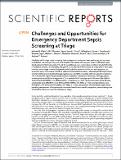| dc.contributor.author | Filbin, Michael R. | |
| dc.contributor.author | Thorsen, Jill E. | |
| dc.contributor.author | Lynch III, James Charles | |
| dc.contributor.author | Gillingham, Trent D. | |
| dc.contributor.author | Pasakarnis, Corey L. | |
| dc.contributor.author | Capp, Roberta | |
| dc.contributor.author | Shapiro, Nathan I. | |
| dc.contributor.author | Mooncai, Theodore | |
| dc.contributor.author | Hou, Peter C. | |
| dc.contributor.author | Heldt, Thomas | |
| dc.contributor.author | Reisner, Andrew T. | |
| dc.date.accessioned | 2020-12-22T16:47:29Z | |
| dc.date.available | 2020-12-22T16:47:29Z | |
| dc.date.issued | 2018-07 | |
| dc.date.submitted | 2018-03 | |
| dc.identifier.issn | 2045-2322 | |
| dc.identifier.uri | https://hdl.handle.net/1721.1/128894 | |
| dc.description.abstract | Feasibility of ED triage sepsis screening, before diagnostic testing has been performed, has not been established. In a retrospective, outcome-blinded chart review of a one-year cohort of ED adult septic shock patients (“derivation cohort”) and three additional, non-consecutive months of all adult ED visits (“validation cohort”), we evaluated the qSOFA score, the Shock Precautions on Triage (SPoT) vital-signs criterion, and a triage concern-for-infection (tCFI) criterion based on risk factors and symptoms, to screen for sepsis. There were 19,670 ED patients in the validation cohort; 50 developed ED septic shock, of whom 60% presented without triage hypotension, and 56% presented with non-specific symptoms. The tCFI criterion improved specificity without substantial reduction of sensitivity. At triage, sepsis screens (positive qSOFA vital-signs and tCFI, or positive SPoT vital-signs and tCFI) were 28% (95% CI: 16–43%) and 56% (95% CI: 41–70%) sensitive, respectively, p < 0.01. By the conclusion of the ED stay, sensitivities were 80% (95% CI: 66–90%) and 90% (95% CI: 78–97%), p > 0.05, and specificities were 97% (95% CI: 96–97%) and 95% (95% CI: 95–96%), p < 0.001. ED patients who developed septic shock requiring vasopressors often presented normotensive with non-specific complaints, necessitating a low threshold for clinical concern-for-infection at triage. | en_US |
| dc.language.iso | en | |
| dc.publisher | Springer Science and Business Media LLC | en_US |
| dc.relation.isversionof | http://dx.doi.org/10.1038/s41598-018-29427-1 | en_US |
| dc.rights | Creative Commons Attribution 4.0 International license | en_US |
| dc.rights.uri | https://creativecommons.org/licenses/by/4.0/ | en_US |
| dc.source | Scientific Reports | en_US |
| dc.title | Challenges and Opportunities for Emergency Department Sepsis Screening at Triage | en_US |
| dc.type | Article | en_US |
| dc.identifier.citation | Filbin, Michael R. et al. "Challenges and Opportunities for Emergency Department Sepsis Screening at Triage." Scientific Reports 8, 1 (July 2018): 11059 © 2018 The Author(s) | en_US |
| dc.contributor.department | Massachusetts Institute of Technology. Center for Biomedical Engineering | en_US |
| dc.contributor.department | Massachusetts Institute of Technology. Department of Electrical Engineering and Computer Science | en_US |
| dc.relation.journal | Scientific Reports | en_US |
| dc.eprint.version | Final published version | en_US |
| dc.type.uri | http://purl.org/eprint/type/JournalArticle | en_US |
| eprint.status | http://purl.org/eprint/status/PeerReviewed | en_US |
| dc.date.updated | 2019-05-30T19:28:27Z | |
| dspace.date.submission | 2019-05-30T19:28:29Z | |
| mit.journal.volume | 8 | en_US |
| mit.journal.issue | 1 | en_US |
| mit.metadata.status | Complete | |
